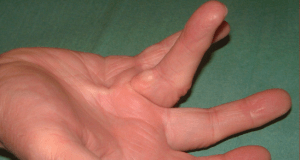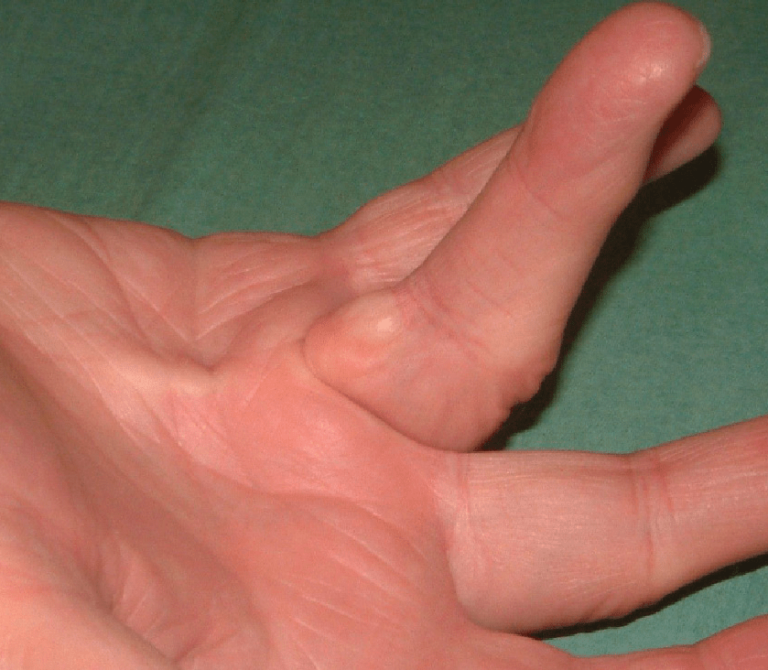About Dupuytren’s Disease
A transcript from Mr Paul Jarrett’s Dupuytren’s video
“Today I would like to talk to you about a condition called Dupuytren’s disease and it is a condition where the fibrous tissue in your palm becomes abnormal and it can cause firm tissue and it can cause your fingers to curl up to a degree and in your hand, the skin of your hand is different to the skin in other places and you can notice that yourself if you move the skin in your palm it does not really move. If you move the skin in other places it does and of course that serves a purpose when you grab things you want to be able to hold on and you don’t want those things to be moving around.
Now, the reason that the skin on your palm is different is because you have fibrous tissue underneath the skin of your palm and it goes down to your bone and goes up to your skin and effectively anchors the skin of your palm onto the bones. Now in Dupuytren’s disease, which is a genetic condition which about one in twenty white coloured people have, those fibrous tissues become thickened and they can tighten up and you can realise that for a number of reasons.
Some people find that they have little nodules or little pits or firm areas in their skin and sometimes you find that you get what almost looks like a tendon underneath the skin. It’s not a tendon it’s kinds of a thick band of fibrous tissue and you find that that develops over time in your palm and a portion of people find that their fingers curl up and it may be that they curl up a very small amount or it may be that actually they curl up very much. It depends on the genetics of it. There are some families who have a very strong genetic predisposition and they curl up a lot like the poor person in this picture here who has a very curled up finger and some people hardly notice that they have any finger curling at all. So it does vary between people.

Now there are a number of different things that can be done about this condition and it is not possible to cure it as it is a genetic condition but it is certainly possible to influence what is happening in your palm. Now for some people they need no treatment whatsoever and a good way of judging that for yourself is if you put your hand flat on the table and you find that your palm is able to touch the table most of the time it is not worth your while having treatment but if you find that when you put your hand flat on the table you find that your palm doesn’t actually touch the table because your fingers are bent up to a degree then it is worth discussing whether there is a treatment option for you and the treatment options roughly go into three different ways.
So we can do an operation called a Fasciectomy operation where we make a wound in your palm and simply remove the fibrous tissue that is causing the contracture and that generally speaking does well and most people end up with a good result following that but it is an operation and it does take a while to recover and again going back to the cause of the condition we are not getting rid of the genetics and therefore it is always possible for it to come back although the majority of people who have an operation don’t require an operation again for that area of their hand.
If you have a Fasciectomy operation it does involve usually wearing a splint at night after the operation for a number of week or quite often a small number of months and it does involve doing quite a lot of exercises to get both your finger straightening maximally and bending maximally with the hand therapists after your operation. Generally it takes about two weeks before you are using your hand fairly well and it takes quite a lot more weeks until it is feeling really back to normal. So that is a Fasciectomy operation. That’s the biggest of the three options from a treatment point of view.
Another way of treating it and it is particularly for people who have a bend in this joint here called the metacarpophalangeal joint and a palpable what we call a cord that almost looks like a tendon although it is fibrous tissue under your skin and there is an operation called a Fasciotomy operation which we do through some incredibly small holes in your palm and if you have ever had a blood test taken, the needle obviously the punctures your skin has got to be sharp and if you were to look very carefully at the end of the needle it almost looks like a tiny little knife.
So what we can do using a needle and local anaesthetic is simply divide that cord of tissue that is causing the contracture; divide it in a number of places so we don’t remove any tissue and then you will find that your finger usually tends to straighten out and of course because we are using a needle, the holes that we do it through are incredibly small and normally heal up very quickly, usually within two or at most three days for most people and therefore your recovery is very quick. Most people only need to take the day of their operation off work or occasionally the day after. It is very rare to need to take more than that and your recovery is very quick. Like the Fasciectomy operation there is of course a risk of it coming back as there are for all these treatments.
Then the final option, which is a bit between the two other options in terms of the size of the treatment, is there is an injection we can do called Collagenase or the trade name for the medication that we inject is called Xiaflex and what that injection does is dissolve the fibrous tissue that is causing the contracture and what we do is we do the injection, then you tend to find that, over a couple of days, your hand does become relatively bruised and swollen.
Then a few days later we put some local anaesthetic into your palm and then manipulate your finger and most of the time it will come out straight although it does take a few weeks, usually about four weeks, before all the bruising and swelling goes away and it take somewhat longer to recover and return to work compared to the Fasciotomy operation but only modestly so and that’s good for lots of different Dupuytren’s conditions particularly for the metacarpophalangeal or proximal interphalangeal joint contractures so it can deal with some contractures or some bending of your finger that is a bit more severe than we can manage for the needling operation but it is much quicker to recover from compared to having the open operation.
One problem with the Collagenase, the Xiaflex injection is the actual medication that we inject is relatively expensive. It is usually about $1350.00 when you get it from the pharmacy and most of the time your health fund won’t cover that and so the cost is borne by yourself.
So it is something that is a genetic condition. We can’t cure it but we can certainly influence what happens in your palm. If you can put your hand flat on the table it’s usually not worthwhile having treatment but of course we can discuss that. Once you can no longer put your hand flat on the table those three treatment options; so the operation, the needling operation or the Collagenase injection all are very useful and for different people different ones have their different merits.
So I look forward to talking to you about your Dupuytren’s contracture and we look forward to seeing you in the Clinic soon.”
If you would like to view Mr Jarrett’s Dupuytren’s video click here
Contact us to discuss your condition or telephone our rooms on 1300 527 738
[/action][/vc_column][/vc_row]

